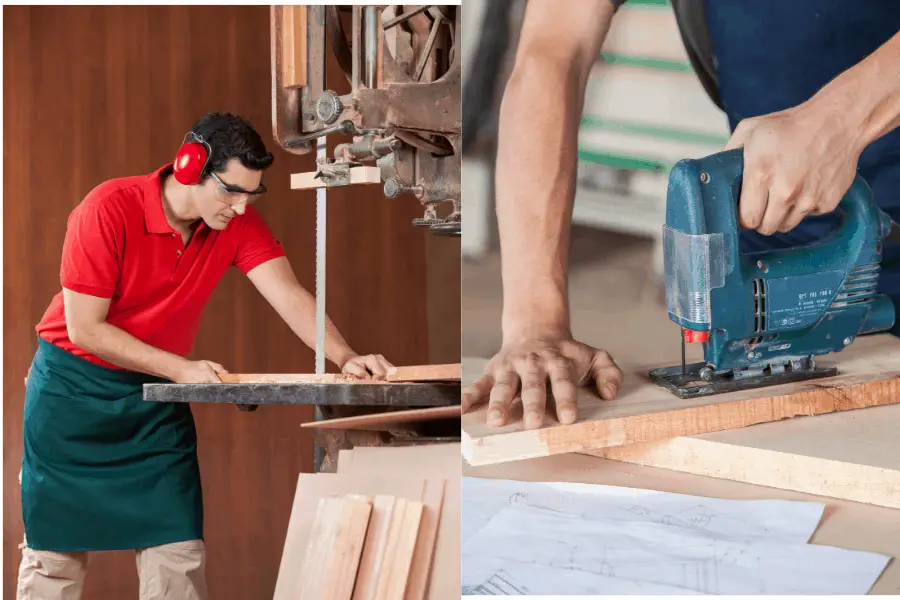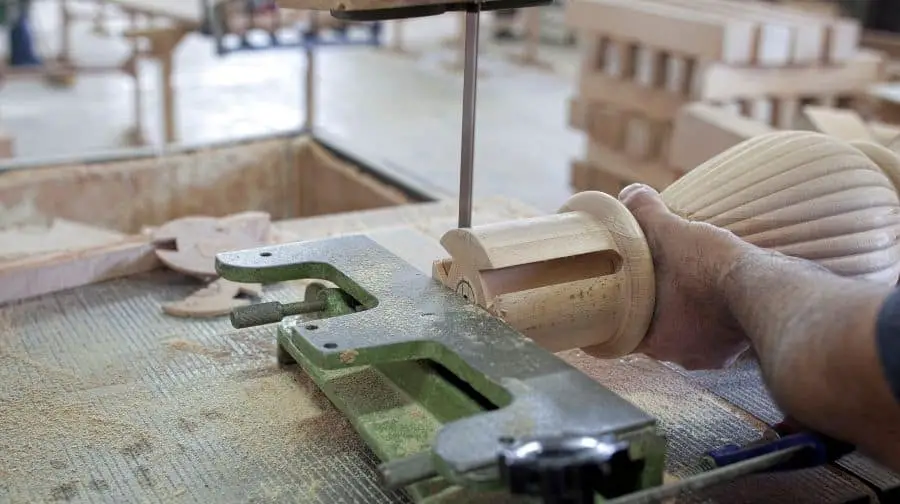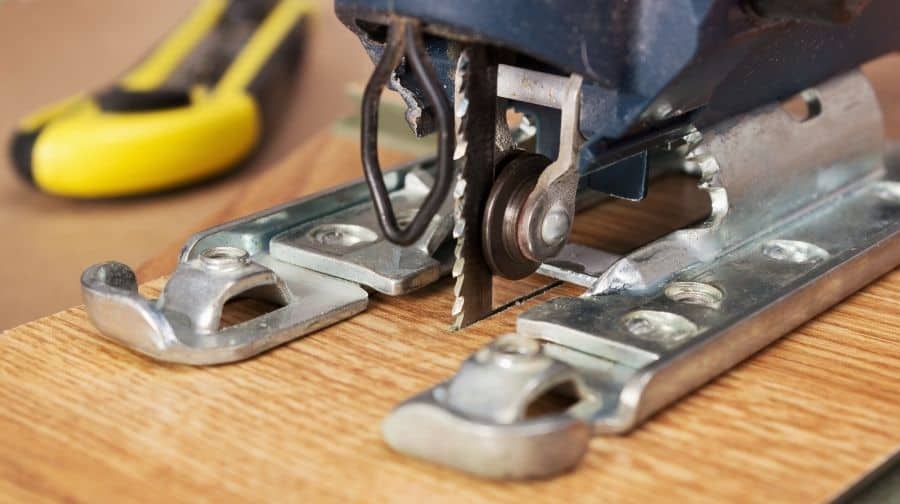
Choosing the right saw for your project and specific cut is super important to reach the highest quality with your woodworking. With so many types of saws and functionalities I decided to research and come up with the definitive guide for the difference between a bandsaw and jigsaw.
What is the difference between a bandsaw and jigsaw? The bandsaw is stationary, it’s blade rotates in a circle downward, the blade teeth are pointed down, it’s better for long precise repeatable cuts, it has the ability to “Resaw” a thick piece of wood into two narrow ones, it pushes the dust downward below the table keeping the dust clear of the cut line and is generally more expensive. The Jigsaw is a mobile hand held saw that cuts in an up and down reciprocating motion, better for short less precise cuts, the blade is shorter so it can’t cut through thick work pieces, it can cut holes, it pulls the dust up onto the cut line and is generally more affordable. Both have the ability to cut angles, circles, and straight lines.
Both saws have their pros and cons depending on what is needed for your cuts and project. Keep reading below to learn more about these amazing tools.
What Is The Difference Between A Bandsaw And Jigsaw?
The difference between a bandsaw and jigsaw is that a bandsaw has a blade that is continuous, while a jigsaw has a blade that is intermittent. Bandsaws are better for cutting larger pieces of wood, while jigsaws are better for smaller pieces or more intricate cuts. Both tools can be used for making curves, but the bandsaw is better suited for making straight cuts.
When it comes to choosing between a bandsaw and jigsaw, it really depends on the project you are working on. If you need to make a lot of straight cuts, then a bandsaw is the better option. However, if you need to make more intricate cuts or smaller pieces, then a jigsaw is the better tool for the job.
Bandsaw:
- Stationary Heavy saw.
- Blade rotates in a circle motion downward attached to two pulley wheels.
- No risk of kickback because it cuts downward.
- Teeth pointed down.
- You cut by pushing wood through blade.
- Better for repeatable precise cuts because you can use a fence to line up your wood.
- Must bring wood piece to the stationary saw
- Blade length is longer so can cut thicker pieces of wood.
- Ability to “Resaw” wood. Which is cutting thick wood into narrower pieces.
- Wood piece size is limited to your bandsaw machine.
- Adjustable blade length.
- Generally more dangerous.
- Can’t cut holes.
- Pushes the dust downward below the table keeping it clear of the cut line.
- More Expensive
Jigsaw:
- Portable handheld lightweight saw.
- Reciprocating blade pushes up and down.
- Teeth are pointed straight to cut in both directions.
- Cuts by pushing the blade through the wood.
- Less precise cuts because it’s hand-controlled.
- Can bring the saw to the wood.
- Blade length is shorter so cannot cut as thick pieces of wood.
- Can cut any size work piece because of the mobility of the saw.
- One of the safest power saws to use because the cutting blade is beneath the wood and way from your fingers.
- Can cut holes.
- Pulls the dust up onto the cut line.
- Has an orbital cutting setting which moves the blade forward and backward as well as up and down.
- More Affordable.
What Do You Use A Bandsaw For?
- Cutting Curves And Circles:
- This is the most popular use for a bandsaw. Curves can be nice accents or design elements in your woodworking. Using a bandsaw for this over a jigsaw gives you much more control and precision with your curves. Because of the adjustable blade length you can save a lot of time cutting circles when you stack pieces after tracing your circle on the top piece. You can cut circles by hand or for more precision you can create a circle cutting jig to attach to your bandsaw.
- Resawing Lumber: Cutting a thicker piece of wood into thinner pieces.
- Use a tall resaw fence and a 5/8 inch 3 teeth per inch blade. Make sure your fence and blade are at a 90 degree angle to the table. Then confirm your work piece has a good right angle on it’s edges. Adjust your bandsaw blade height slightly higher than your wood for max control. Use slow and steady pressure to push the wood through the blade.
- Cutting Notches:
- It is better to use a bandsaw for notch cutting compared to a tablesaw. It is less dangerous because there is no kickback and the top side of the notch will look ok but the bottom side will have unsightly additional cuts making it only showable on one side. With a bandsaw you can easily slide your work piece in and out without kickback because it cuts downward. No unsightly cuts on the bottom side because it is a 90 degree vertical cut.
- Bookmatching Figured Wood:
- You cut the piece of wood to split it in half like opening a book. This is good for figured wood because it highlights the movement of the figures in the wood in a unique way. They will match perfectly and you can glue them together to use.
- Repurposing Scrap Wood: (Turning logs into Lumber)
- You can measure out cuts in the log to run through the bandsaw to create smaller pieces of wood for future projects.
- Can Cut Non Ferrous Metals.
Why Is It Called A Bandsaw?
They call it a “bandsaw” because the blade is a continuous band of steel with teeth pointed downward running over two pulley wheels above one another but sometimes horizontally connected to the base of the machine in a downward motion.
Dating back as far as 1808 early bandsaws were powered by water, steam and foot peddle before electricity was used for them.
If your interested in learning more about the history of Bandsaws here is a great link that goes into the full history. http://www.woodworkinghistory.com/glossary_bandsaw.htm

Do I Really Need A Bandsaw?
If you aren’t going to be resawing lumber, bookmatching figured wood, or repurposing scrap pieces of lumber there are ways to make due without a bandsaw for your projects.
In the rare case you need to do one of the above tasks take the material somewhere and have it cut.
Power Tool Alternatives To A Bandsaw:
- Jigsaw: a light portable electric saw which uses a reciprocating blade to cut irregular curves, such as stenciled designs, in wood, metal, or other materials.
- Scrollsaw: is a small electric or pedal-operated saw used to cut intricate curves in wood, metal, or other materials.
Hand Tool Alternatives To A Bandsaw:
- Frame Saw: is a type of saw which consists of a relatively narrow and flexible blade held under tension within a (generally wooden) rectangular frame (also called a sash or gate).
- Coping Saw: is a type of bow saw used to cut intricate external shapes and interior cut-outs in woodworking or carpentry.
- Fret Saw: is a bow saw used for intricate cutting work which often incorporates tight curves.
What Do You Use A Jigsaw For?
Jigsaws are versatile power tools that are most commonly used to cut curves, circles, patterns, shapes, circular holes, square holes, straight lines and handles. This saw is a great portable option that has many benefits over the stationary bandsaw.
Why Is It Called A Jigsaw?
The term jigsaw comes from the word “Jig” which is a device that holds a piece of machine work and guides the tools operating on it. A Jigsaw has also been called a saber saw in the past as well as Scroll Saws have been referred to as Jigsaws.
Albert Kaufmann invented the principle of the electric saw. He noticed the very fast up and down motion of the needle on his wife’s sewing machine. By clamping a saw blade in the sewing machine he was able to make precise curved cuts in wood. This lead to the invention of the Jigsaw.

Do I Really Need A Jigsaw?
There are alternatives to jigsaws. The hand tool alternatives will be less expensive but the power tool alternatives are more costly. Overall a jigsaw is a more affordable and versatile power tool compared to it’s alternatives.
Power Tool Alternatives To A Bandsaw:
- Bandsaw: is a power saw with a long, sharp blade consisting of a continuous band of toothed metal stretched between two or more wheels to cut material.
- Scrollsaw: is a small electric or pedal-operated saw used to cut intricate curves in wood, metal, or other materials.
Hand Tool Alternatives To A Bandsaw:
- Frame Saw: is a type of saw which consists of a relatively narrow and flexible blade held under tension within a (generally wooden) rectangular frame (also called a sash or gate).
- Coping Saw: is a type of bow saw used to cut intricate external shapes and interior cut-outs in woodworking or carpentry.
- Fret Saw: is a bow saw used for intricate cutting work which often incorporates tight curves.
Jigsaw VS Bandsaw
When it comes to the debate of jigsaw vs bandsaw there are a few things to keep in mind.
First, a jigsaw is going to be better for more intricate cuts. If you need to make a cut that is not perfectly straight, or if you need to make an curved cut, then a jigsaw is the tool for the job.
Second, a bandsaw is going to be better for making long, straight cuts. So, if you need to make a cut that is longer than about 18 inches, or if you need to make a perfectly straight cut, then a bandsaw is the better option.
Third, both of these tools can be used for making cuts in wood, metal, and plastic. However, each type of material will require different types of blades. So, make sure you have the right blade for the material you are cutting.
Finally, both of these tools can be dangerous if they are not used properly. So, make sure you read the instructions before using either tool and always wear safety glasses when using either tool.
